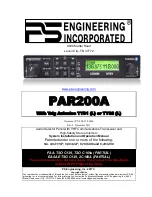
EFD1000 E5 Dual Electronic Flight Instrument (EFI) Install Manual
DOCUMENT # 900-00041-001
PAGE 166-226
REVISION D
© Copyright 2019 Aspen Avionics Inc.
10.6.13
EMI Test
Perform the EMI tests in this section with the EFD1000 E5 System (with associated
operating peripheral equipment, RSM, ACU and EA100) and the autopilot engaged in any
mode. In the tests below, the “Threat Equipment” is the EFD1000 E5 system.
EFD1000 E5 System as the EMI Victim:
Monitor the EFD1000 E5 System for any indication of interference. Monitor the EFD for
Flags, Red-X’s, Red Slashes, heading changes, altitude changes, airspeed changes,
attitude changes or any error messages while performing the following tests.
Assure that the EA100 A/P AHRS lamp remains extinguished and there is no
uncommanded autopilot-disconnect while performing the following tests:
1)
Operate engine(s) and verify no interference.
2)
Transmit on all Comm radios for 20 seconds each at 118.000MHz, 126.900MHz, and
136.950MHz.
3)
Turn on all transponders, DMEs, Weather Radar, and all other pulse-type equipment
for 20 seconds each.
4)
Operate all aircraft lighting including position lights, strobe lights, navigation lights,
and all other forms of lighting for 20 seconds each.
5)
Operate all environmental equipment including fans, air conditioning, heaters, and all
other forms of environmental control equipment for 20 seconds each.
6)
Operate fuel pump(s), deice boots, windshield heat, prop heat, flaps.
7)
Operate autopilot servos, yaw damper, and all electric trim servos.
EFD1000 E5 System as the EMI Source:
SYSTEM DESCRIPTION
POSITION
EFD1000 E5 System
Pass Fail
Tests are to be conducted with the aircraft operating with engine(s)
running
COMMUNICATIONS
VHF COMMUNICATIONS
Check field or local frequencies (ATIS, local ground, tower, etc.) to
listen to the quality of the received signals from those systems. Record
local or field frequencies used. Listen for objectionable audio noise. If
noise is present shut down the EFD1000 E5 System to determine if it is
inducing the noise. Testing should also be accomplished on 118.00hz,
126.900MHz, 136.950MHz, 120.00 MHz and 125.00 MHz.
No 1
No 2
COCKPIT INTERCOM
Initiate several conversations between crew positions and verify
interference free communications while monitoring the effects of the
Threat equipment.














































